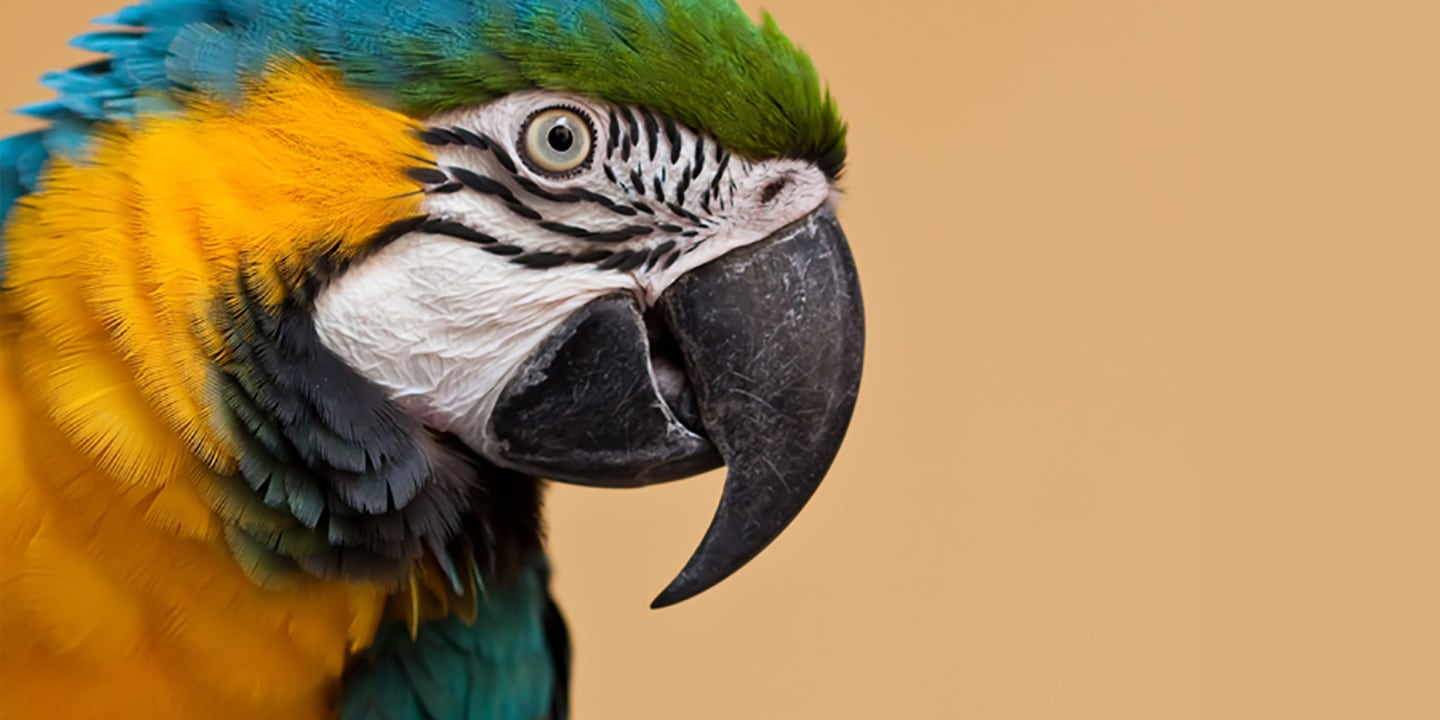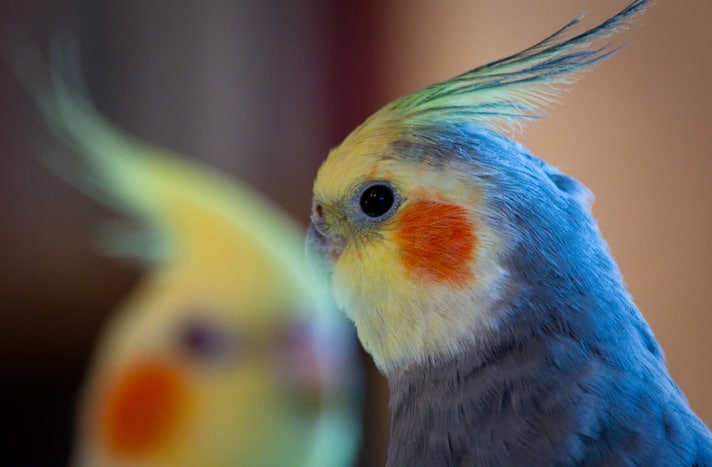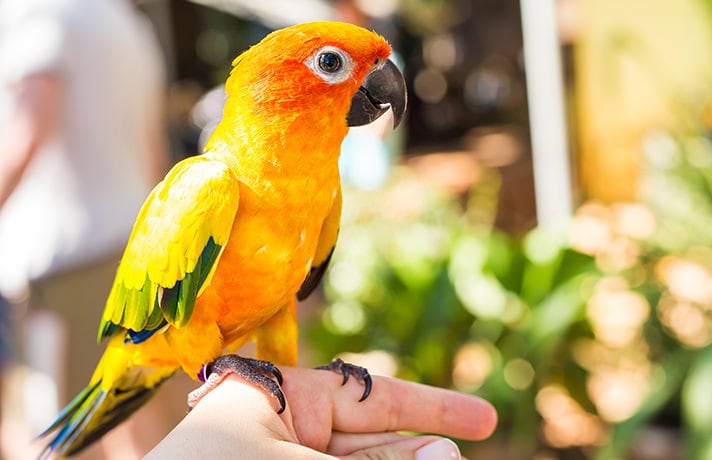Why train your parrot to fly? There are many good reasons, but the first is to maintain your pet bird’s health. A bird’s form, function and anatomy all evolved for the purpose of flight. Even a parrot’s metabolism, which is higher than that of a mammal’s, supports flight.
For a second reason, look no further than the fact that flight training is fun. When you work with your parrot on flight training exercises, you encourage an active, healthy bond between you and your pet bird. Watching your pet bird fly and encouraging it to fly to you is rewarding and entertaining.
Like playing a jazz piano, flight training requires attention and adherence to basic principles to develop and keep the harmony, rhythm and timbre from disappearing. Like making music, you and your parrot have to learn and practice the method first. Only after that can you let the melody out to fly on its own.
Training The Person
Before we talk about how to train the pet bird, let’s talk about how to train the person. A number of tapes and books can help you teach simple training behaviors to your pet bird. Establish these basic training tricks before moving on to working with flight. Although these references don’t specifically address working with flighted birds, I find that the principles of trick training and those of flight training are the same.
Trick training teaches you how to communicate with your bird. My mentor for trick training was Tani Robar, who has produced a number of training tapes. Karen Pryor’s book, “Don’t Shoot the Dog, the New Art of Teaching and Training” is another excellent place to learn about positive reinforcement and clicker training.
Once you’ve worked out a foundation for communication with your pet bird by teaching some simple behaviors — such as the wave, the shake, retrieving an object, etc. — you are ready to move on to work on flight training.
Get Social
How to socialize an animal is to give it the tools it needs to succeed in a society. In the world of parrots, this means to teach a bird that change is wonderful, that new foods are exciting to try and that new people are fun. In other words, to teach the bird to be adaptable in the constantly changing human world.” href=”/socialization/”>socialized is your pet bird’s By “socialized,” I mean that the pet bird feels comfortable in various environments and around different distractions. If your bird is fearful or prone to being startled, you are not going to be able to affect the parrot’s behavior. A startled bird that has not developed good flying skills is at risk because she will not be able to control her flight. A bird unable to control her flight is more likely to fly into obstructions, such as windows and walls.
How do you socialize your pet bird? Get your pet bird out of the house. Use a carrier to take your pet bird for walks around your yard or your neighborhood. Take your parrot to a bird-friendly house for a visit. (Note: Be careful of dogs, cats and windows.) Roll your bird’s cage outside on your deck or back yard so that your pet can watch the world go by. Supervise your bird while she enjoys the outdoors. Better yet, build an aviary for it to play in on nice afternoons. For a number of years, I took my pet birds to nursing homes for visits. The options for socialization are limited only by your imagination.
Start Exercising
Flight requires a great deal of muscle and energy. A bird that has been in a cage most of her life or relegated to a perch is in no condition to begin the strenuous exercise required for flight. A small bird that has been flighted most of her life is going to be in much better physical shape than a large bird that does not receive flight practice.
For the majority of pet birds that have had their wing feathers trimmed, beginning flight training is more about gradual conditioning by encouraging short flights than it is about training.
Like any physical activity, in order to become proficient, the bird has to learn to develop important skills — how to maneuver, turn, fly up, fly down and land. A bird matures into these abilities, but these are learned skills that need to be practiced. In the wild, a bird learns flight skills at fledging.
Larger species require a lot more time to master these skills than the smaller species. Some pet birds had their wing feathers trimmed before they had the opportunity to proficiently learn these important flight skills.
Reward For A Job Well Done
Reward your bird for the behaviors that you want her to learn. You have to know your bird well enough to understand what she finds rewarding or what will work to reinforce the desired behavior. Most birds respond well to food treats such as almonds, nuts or seeds. You also can try objects that the bird is particularly fond of or situations that the bird finds reinforcing.
A friend of mine uses a mirror to reinforce a recall for Peanut, her cockatiel. Like most male cockatiels, Peanut cannot resist his reflection. I recently watched a video with another great example of a creative reinforcer; a mitred conure flew to his owner for the opportunity to crawl in a fish bowl full of bird toys. Again, the limits to finding reinforcers are the limits of your observational skills and your willingness to experiment with your bird.
OK, so you’ve taught your pet to wave, and you’ve taken your bird to the store so many times that your spouse is embarrassed to be seen with you. Now, where do you begin?
Recall Flying
Recall and Target flying to one of the bird perches are two beginning exercises. If you are starting with a young, busy baby bird, “recall” is the first flight training skill that you want to teach. It is usually easy to start with a recall because if you have a flighted baby bird, all that you are really doing is “capturing” the behavior of “fly to me” and reinforcing it.
Again, your goal is to capture the behavior that you want by rewarding the bird. Once you have the behavior captured, you teach your parrot to associate the behavior with a cue. Once the behavior is learned, the sequence becomes: cue-bridge-reward. Let’s start. The very first time that your baby bird hops to your arm, make a fuss, offer praise, and give your bird a treat. Soon, that young bird learns that very good things happen if she flies to you. She will fly to you more often.
Baby birds usually are reinforced with praise, but follow up that reward with a food treat. Save favorite foods only for training rewards. You want the bird to associate “fly to me” with a very powerful reinforcer. In time, you are going to want your bird to fly to you even though, in her mind, she has “better things to do.” You want your bird to associate your cue with a “jackpot” reinforcer — something irresistible. The best jackpot reinforcer is almost always the bird’s favorite food treat.
Once the bird is flying to you consistently throughout a period of days for its reward, start working on putting this behavior on cue. A cue signals to the bird that it is time to fly to you. To teach the cue, you simply anticipate the “fly to me” by watching the bird’s body language and cuing almost simultaneously when the bird starts to take flight.
Once the bird flies to you, you can bridge using a clicker or the word “good.” ”Good”can be used with an enthusiastic inflection. A bridge word is a word that signals to the bird that it has performed the behavior expected and that a reward is forthcoming. Immediately after the bridge, reward the bird with a food treat.
What cue should you use? Parrots appear to respond better to visual cues than to verbal cues, but I use both when I am doing a recall. You can use whatever you are comfortable with. I hold my hand horizontally (like a perch) and call, “Come here.” If you have a larger bird like a macaw or a Moluccan cockatoo, you might cue them to fly to your arm. Although you are working on recalls at home during this early training stage, later you may want to work in a larger space (such as a gymnasium). It can be very effective to hold your hand or arm above your head and call “Come here” to get the bird to come to you from a big fly about around the room. Birds tend to want to land on the highest perch.
I always reward a bird when it flies to me, whether I cue the pet bird or not. However, after the pet bird is fluent at flying to me and comes to me without a cue, I do not always reward it with a food treat. I reward with praise and save the food treat for when it comes on cue.
I reward the bird, because flying to me is a difficult behavior to keep consistent unless the pet bird always considers me to be a safe and fun place to land. I also worry that my birds could escape outside, and I want them to be in the habit of flying to me. If a bird escapes outside, I won’t care if they come to me on cue or not. I will be absolutely ecstatic if they just fly back to me — period.
On the other hand, the reason that I only reward the cued response with a food treat is because this is the “jackpot” reward that lets the pet bird know that she has correctly performed the directed behavior of “recall on cue.” In this later stage of flight training, you want the bird to understand that it only gets the “jackpot” when it comes on cue. You want the bird to respond to the cue fluently.
So, now you have a playful, interested parrot that flies to you whenever you say “Come here.” I don’t have to tell you — this is really fun! There is a lot more to this flight, but this is a good start.
Excerpt from BIRD TALK Magazine, May 2006 issue, with permission from its publisher, Lumina Media.
Posted By: Chewy Editorial
Featured Image: Via Pixabay
Share:









